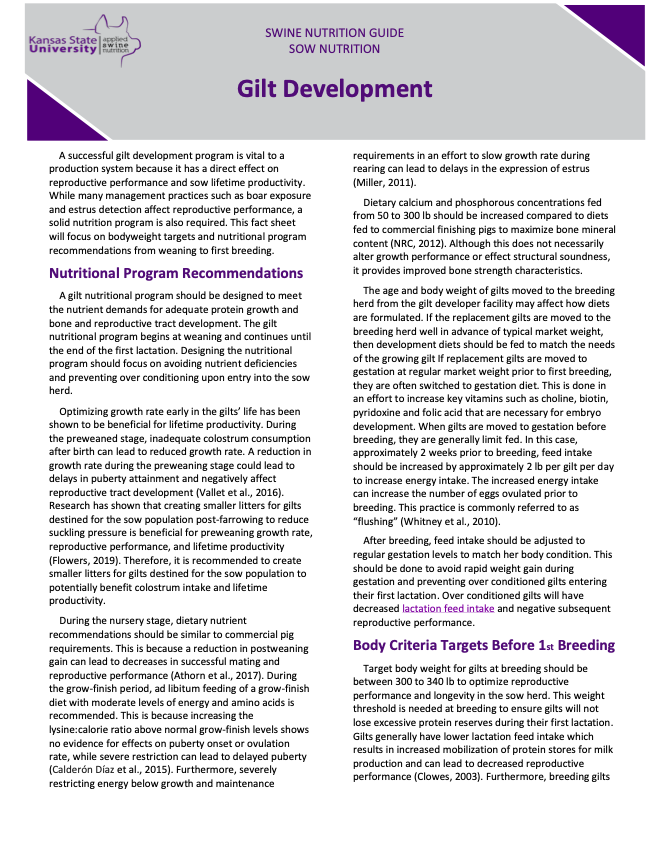Nutritional Program Recommendations
A gilt nutritional program should be designed to meet the nutrient demands for adequate protein growth and bone and reproductive tract development. The gilt nutritional program begins at weaning and continues until the end of the first lactation. Designing the nutritional program should focus on avoiding nutrient deficiencies and preventing over conditioning upon entry into the sow herd.
Optimizing growth rate early in the gilts’ life has been shown to be beneficial for lifetime productivity. During the preweaned stage, inadequate colostrum consumption after birth can lead to reduced growth rate. A reduction in growth rate during the preweaning stage could lead to delays in puberty attainment and negatively affect reproductive tract development (Vallet et al., 2016). Research has shown that creating smaller litters for gilts destined for the sow population post-farrowing to reduce suckling pressure is beneficial for preweaning growth rate, reproductive performance, and lifetime productivity (Flowers, 2019). Therefore, it is recommended to create smaller litters for gilts destined for the sow population to potentially benefit colostrum intake and lifetime productivity.
During the nursery stage, dietary nutrient recommendations should be similar to commercial pig requirements. This is because a reduction in postweaning gain can lead to decreases in successful mating and reproductive performance (Athorn et al., 2017). During the grow-finish period, ad libitum feeding of a grow-finish diet with moderate levels of energy and amino acids is recommended. This is because increasing the lysine:calorie ratio above normal grow-finish levels shows no evidence for effects on puberty onset or ovulation rate, while severe restriction can lead to delayed puberty (Calderón Díaz et al., 2015). Furthermore, severely restricting energy below growth and maintenance
requirements in an effort to slow growth rate during rearing can lead to delays in the expression of estrus (Miller, 2011).
Dietary calcium and phosphorous concentrations fed from 50 to 300 lb should be increased compared to diets fed to commercial finishing pigs to maximize bone mineral content (NRC, 2012). Although this does not necessarily alter growth performance or effect structural soundness, it provides improved bone strength characteristics.
The age and body weight of gilts moved to the breeding herd from the gilt developer facility may affect how diets are formulated. If the replacement gilts are moved to the breeding herd well in advance of typical market weight, then development diets should be fed to match the needs of the growing gilt If replacement gilts are moved to gestation at regular market weight prior to first breeding, they are often switched to gestation diet. This is done in an effort to increase key vitamins such as choline, biotin, pyridoxine and folic acid that are necessary for embryo development. When gilts are moved to gestation before breeding, they are generally limit fed. In this case, approximately 2 weeks prior to breeding, feed intake should be increased by approximately 2 lb per gilt per day to increase energy intake. The increased energy intake can increase the number of eggs ovulated prior to breeding. This practice is commonly referred to as “flushing” (Whitney et al., 2010).
After breeding, feed intake should be adjusted to regular gestation levels to match her body condition. This should be done to avoid rapid weight gain during gestation and preventing over conditioned gilts entering their first lactation. Over conditioned gilts will have decreased lactation feed intake and negative subsequent reproductive performance.
